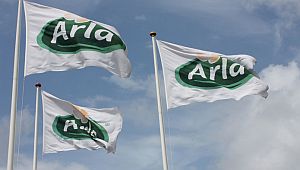Fresh Milk,
Food Waste,
Arla
Arla Removes 'Use-by' Dates on Branded Fresh Milk to Help Reduce Food Waste
Thousands of adults across Britain admit they struggle to understand all of the labels on food and drink packaging, resulting in many binning perfectly good produce, new research* has revealed.
 A poll of 2,000 adults* by Arla Foods found there was uncertainty across the board, with the difference between «best before' and «use by' dates, as well as storage information and even the salt, sugar and fat content leaving 85 percent of the nation confused.
A poll of 2,000 adults* by Arla Foods found there was uncertainty across the board, with the difference between «best before' and «use by' dates, as well as storage information and even the salt, sugar and fat content leaving 85 percent of the nation confused.
The study revealed that whilst three-quarters (77 percent) of respondents check food and drink packaging before they purchase, only 15 percent are confident they can decipher everything on the label. This includes «best before' and «use by' dates with over a third (34 percent) of Brits unsure of the difference, and 11 percent believing them to be the same thing. This confusion means a third (34 percent) end up binning food if past its «best before' date, while another 38 percent do the same once the product has passed its «use by' date.
The stats emerged in a study by dairy company Arla Foods, who will become the first dairy company to remove «use by' dates on all branded fresh milk and replace with «best before' dates only, in a bid to cut confusion and help reduce food waste.
To ensure this change helps consumers work out when their milk is still good to be used, Arla is calling on the nation to go online and vote for the label they want to see on milk bottles.
Fran Ball, Director of Quality, Environment and Safety, Arla Foods UK, said: «Our research shows that consumers are clearly confused about labelling on their food products, particularly when it comes to use by and best before dates.
«As a nation, we waste around 490 million pints** of milk every year. By making some changes to the labels on our fresh milk and yogurts, we want to make people’s lives a little easier and help to cut food waste in the home. To make sure everyone can easily understand our packaging, we’re asking them to tell us which label they want to see on our bottles.
«Because we are owned by farmers, we know how much hard work goes into producing milk to Arla’s high quality standards. If changing the label gives people the confidence that their milk might still be ok for a few further days after the date on the bottle, we’ll all play a part in reducing food waste.»
This comes as research shows more than half (59 percent) of respondents assuming milk is unsafe to drink once the date has passed, and 14 percent admitting they would bin it without checking to see if it could still be used.
Shoppers are also getting more familiar with fruit and veg, with two-thirds (66 percent) admitting they would happily consume once the date has passed. Also, likely to stay in the cupboard past its «best before' date was tinned food (70 percent), sweets and chocolate (72 percent) and dried products such as nuts and cereal (71 percent).
Kate Quilton, Food Journalist, said: «There is no reason to throw away food or drink that is past its best before date — in most cases it’s perfectly fine to still enjoy rather than waste it. A simple check or sniff of the food product will give you a good indication as to whether the product is edible. Arla’s pledge to change its date labels is a great way to help simplify this message and educate consumers that «best before' doesn’t always mean it's ready to be thrown away, and that there’s some life in your food yet!»
The new «best before' labels will roll-out across all of Arla’s branded fresh milk including Cravendale, BOB and Goodness, with the entire yogurt portfolio also making the switch in 2020.
Standard fresh milk can often last a few days (typically 2−3 days) beyond the date on bottle, filtered milks like Cravendale and Big Milk will often last longer.
*OnePoll survey polled 2000 UK adults between 2−7 August 2019
*WRAP www.wrap.org.uk/content/opportunities-reduce-waste-along-journey-milk-dairy-home